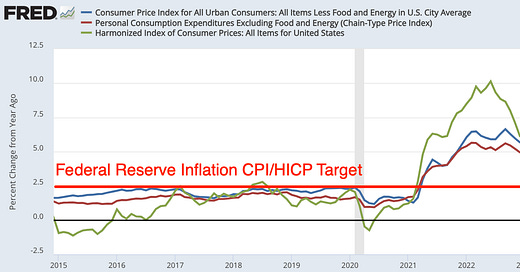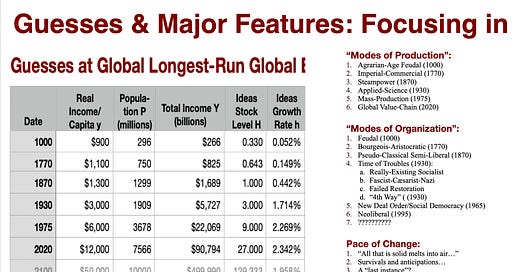
Discover more from Brad DeLong's Grasping Reality
Our Ancestors Thought We'd Build an Economic Paradise. Instead We Got 2022
“Slouching Towards Utopia” Time Magazine launch piece; commissioned by Lucas Wittman
Human history before 1870 was generally awful. But after 1870 we began to wriggle out from the traps that we were then in. So most people back then would, had they been able to foresee our immense technological power and sophistication, have expected us to have built our world that we live in today into a paradise, a utopia.
We manifestly have not.
What went wrong?
The Sweep of History
Back before 1870 the human population was always too large relative to our low (and slowly improving) level of technology, and our limited ability to harvest natural resources. Why? Because poverty made infant mortality very high, and patriarchy meant that women’s durable social power (with a few exceptions) came pretty much only from being mothers of surviving sons. Slowly-improving technology meant that there was not much room for this generation to be more numerous than the last and for people to still get fed: think of an average pre-1870 population growth rate of about 2.5% per generation. If you then do the math, you see that, in such a world, about one woman in three was left without surviving sons. Hence the drive to reproduce more—even if you already had living sons, to have another as insurance—was immense. That drive kept population growing whenever any technological headroom to support higher productivity emerged—breed strains of rice that grow more rapidly so you can get two crops a year, and find in a few centuries that the population of wetland Asia has doubled. That kept humanity poor. Before 1870 this world was a Malthusian world.
But there was even worse: In such a poor world, only a few could have enough. And the only way the few could get enough for themselves and their children was to find a way, through force and fraud, to take a substantial share of what the rest were producing and grab it for themselves. That meant that those who directed human society’s energies did so not toward making humanity more productive but, rather, making the force-and-fraud exploitation-and-extraction system run better for themselves. That meant that those ideas that were promoted and that flourished were not those that made humanity capable of doing more things more efficiently and effectively, but rather those that shored up the force-and-fraud exploitation-and-extraction system. That meant that the rate of technological advance was slow.
My crude guess is that there has been as much proportional technological progress—useful ideas discovered, developed, deployed, and then diffused throughout the global economy—making humanity more productive in the 150-year span since 1870 as there were in the entire nearly 10,000-year span since the beginnings of the creation of agriculture around the year 8000. Moreover, from 8000 to 1870 poverty, patriarchy, and slow technological progress kept humanity under the spell of the Devil of Malthus, with nearly all of the potential benefits of better technology being eaten up by population growth and resulting resource scarcity. Think of something like $900/year—the living standard of the poorest half-billion of our eight billion today—as the living standards of a typical human back before 1870.
Then, after 1870, everything changed.
Economic historians debate, and will debate as long as there is a human species, exactly why the change came in 1870. They debate whether the change could have come earlier—perhaps starting in Alexandria, Egypt back in the year 170 when Emperor Marcus Aurelius Antoninus ruled in Rome, or in the year 1170 when Emperor Gaozong ruled in Hangzhou. They debate whether we might have missed the bus that arrived in 1870 and still, today, be trapped in a Malthusian steampunk, gunpowder-empire, or neo-mediæval world.
But we did not. A lot of things had to go right and fall into place to create the astonishingly-rich-in-historical-perspective world we have today. Three key elements—modern science and the industrial research lab to discover and develop useful technologies, the modern corporation to develop and deploy them, and the globalized market economy to deploy and diffuse them throughout the world—fell into place around 1870.
Hopes for the Post-1870 Era
Ever since, advancing science, turned into technology by industrial research labs, deployed at scale by modern corporations, and then diffused throughout the world by that magnificent crowdsourcing mechanism that is the global market economy have taken us on a wild ride. The rate of global technological progress, a rate that was perhaps 0.05%/year before 1500, 0.15%/year over 1500-1770, and perhaps 0.45%/year over 1770-1870, went into high gear, and has averaged 2.1% per year on average since. The deployed-and-diffused technological capabilities of humanity have thus roughly doubled every generation since 1870.
Soon after 1870 people got a clue that something had changed. Looking back at 1870-1914, economist John Maynard Keynes was to write between the world wars of how it had been:
economic Eldorado… economic Utopia… that Devil [of Malthus]… chained up and out of sight…. What an extraordinary episode!…
The forces unleashed in 1870 meant that “the economic problem may be solved, or be at least within sight of solution, within a hundred years… is not… the permanent problem of the human race… [which will be] how to occupy the leisure, which science and compound interest will have won for him, to live wisely and agreeably and well…”
Humanity before 1870 had been stymied because anæmic technology, limited natural resource, patriarchy, and poverty had kept us from being able to bake an economic pie sufficiently large to even raise the possibility that everybody could have **enough**. But with the coming of the power to bake a sufficiently-large economic pie, surely all that would fall away, no?
John Maynard Keynes had certainly thought so: “We shall once more value ends above means and prefer the good to the useful. We shall honour those who can teach us how to pluck the hour and the day virtuously and well…”
Friedrich Engels also thought so: with a sufficiently-large economic pie, with enough, the power system of exploitation-and-extraction:
ceases of itself. The government of men is replaced by the administration of things.… Ruling is not ‘abolished’, it atrophies…
They all thought that once you had solved the baking problem, the slicing and tasting problems—sharing and enjoying the pie, using our material resources to make us all healthy, secure, safe, and happy—would be straightforward also. Thus many who lived before 1870 would be very surprised to see us in our manifestly not-paradise, and to see how completely the problems of slicing and tasting the economic pie have flummoxed us.
What Went Wrong?
So what happened? Why did we fail to grasp a near-utopia, why have we not made the world a near-paradise?
Letting the market economy rip to solve the problem of making enough had consequences. Thus the first half of the Big Story of twentieth-century economic history is a triumphant one. Friedrich von Hayek was a genius. He saw clearly that the market economy, when coupled with industrial research labs, modern corporations, and globalization, was the key to unlocking the cage keeping humanity desperately poor. He thus preached the gospel: “The market giveth, the market taketh away: blessed be the name of the market.” We should, he thought, be satisfied with the fact that there was a large-enough pie, count our blessings, and ignore the problems of slicing and tasting it properly.
But people would not, and did not, stand for that. They demanded, instead: “The market was made for man; not man for the market.” Karl Polanyi saw this most clearly: that humans thought they should have more rights and, indeed, needed more rights than just property rights. The market’s treating those whom society saw as equals unequally, or those whom it saw as unequals equally, brought social explosion after explosion, blocking the road to utopia.
The New Deal Order & Its Collapse
Perhaps humanity came close to an institutional-societal setup to tackle the problems of slicing and tasting. After World War II in what historian Gary Gerstle calls the New Deal Order, the Global North at least produced the fastest economic and social progress ever seen. It was a shotgun marriage of Friedrich von Hayek to Karl Polanyi blessed by John Maynard Keynes. And it worked.
But this New Deal Order failed its sustainability test in the 1970s. The world made the Neoliberal Turn.
There were complaints. There was inflation—most notably oil shock-driven rising gasoline prices. There were business cycles. There was overbureaucratization. And there were too many programs and too many institutions that people saw as seeing giving too much money to people—from greedy Teamster union members to “welfare queens”—who had no proper right to it. Society may not know what “social justice” is, but it knows what it is not. The New Deal Order ran into the buzzsaw of the neoliberal challenge in the 1980s. The New Deal Order succumbed.
Yet the New Deal Order had delivered a lot—the slow productivity growth and inflation of the 1970s notwithstanding, the Vietnam War notwithstanding. Yes, mistakes were made. Yes, the New Jerusalem was not built. But the effect—the discrediting and replacement of the New Deal Order—seems disproportionate to the causes.
Back in 1993-1995 I was working for the Clinton administration. Back then we hoped to resurrect things. We hoped that 1981-1993 was a mistaken diversion from the best path. We hoped we could reverse course and get back to what had manifestly worked so well in the first post-WWII generation.
So, led by Bill Clinton, we placed a bet: first, economic policies to reverse the growth-retarding mistake of the Reagan and George H.W. Bush administrations; second, hope those would create a fast-growth high-tech high-investment high-employment future for America; third, with faster growth would come greatly reduced economic anxieties—and so burn the thread that the uppity undeserving were getting ahead of themselves out of American politics—then, fourth, once again pursue a pragmatic politics of what worked equitable growth, rather than a destructive politics of finding and punishing enemies.
The Neoliberal Order
It did not work. It was replaced by a Neoliberal Order that was hegemonic, in Gary Gerstle’s terms: it shaped the core ideas of politics and governance not just for those who cheerled for it, but even and perhaps especially for those who resisted it. We could not restore the New Deal Order. We could not even restore a simulacrum of it in Left-Neoliberal sheep’s clothing.
The New Deal Order had required rapid growth, so that worries that its social-insurance system allowed the undeserving to take advantage of the hard workers and the job creators were drowned out by the music of “it’s getting better all the time.” The New Deal Order required a politics of coalitions in which people agreed they had a good thing going, and the big question was whether they should (as the center-right wanted) prioritize fixing the leaks in the roof or (as the center-left wanted) prioritize completing the addition.
Without all of those, it was unsustainable.
And so we working for and with Bill Clinton found ourselves, instead, working to cement the Neoliberal Order just as Eisenhower had found himself working to cement the New Deal Order back in the 1950s. Whether tilting to the left or to the right, Global North governments indulged in a very aggressive pursuit of free trade and globalization, a great weakening of unions, privatization, deregulation, and an extraordinary reduction of the degree of progressivity in the tax system. A belief that market mechanisms were almost always superior to bureaucratic or political mechanisms. And, for many, a belief that income inequality needed to be increased in order to reinvigorate economic growth, and that that greater inequality was not an unfortunate necessity but rather a positive good—giving the job-creators and the hard-workers what they deserved.
Was this transition from New Deal to Neoliberal Order inevitable? I still think that, on the west side of the Atlantic, it might well have worked, had George W. Bush’s team not gotten him elected by a 5-4 vote, and had all the Republican worthies not followed Newt Gingrich down the road that has led them to their current thralldom to Donald Trump and his fellow grifters. I still think that, on the east side of the Atlantic, it might have worked, had Britain’s Liberal Party been willing to support centrist technocrat Gordon Brown rather than rightist ideologue David Cameron.
But the Neoliberal Order entrenched itself in the Global North. But it failed to deliver on its own promises.
The Neoliberal Order did not restore the rapid growth of prosperity by reinvigorating entrepreneurship—rather, growth slowed further as the cult of short-term financial results undermined the ability of businesses and governments to make long-term mutually-reinforcing common-prosperity investments.
The Neoliberal Order did not properly distribute prosperity to the deserving and their just deserts to the undeserving—instead, rent-seeking strengthened among the plutocracy, to which kleptocracy added itself.
The Neoliberal Order did not restore moral order and solidity to Global North society—things continued to fall apart and the center held less. and less.
The only one of its promises the Neoliberal Order in the Global North fulfilled was to greatly increase inequality of income and wealth. It led to plutocracy, tinged with kleptocracy.
And yet the Neoliberal Order remained entrenched. Up until 2008 it was even triumphant. And it proved stubbornly and persistently resistant to erosion since.
It hung on after 2003, even after George W. Bush’s breaking of the Concert of the World and even of the Western Alliance in favor of a “Coalition of the Willing.”
It hung on after 2006, even as the hope that information technology would restore golden-age economic growth rates ebbed away.
It hung on after 2008, even as the claim that depressions were a thing of the past collapsed.
It hung on after 2010, even as the great-and-the-good did not just put the task of restoring full employment on the back burner, but took it off the stove entirely.
Thinkers like Robert Kuttner blame relatively small groups and individuals for the persistence of the Neoliberal Order: “cultural leftists”, especially high-tech ones, who welcomed de-bureaucratization; Ralph Nader, who welcomed deregulation; Bill Clinton, who was opportunistic; Barack Obama, who was inexperienced and cautious. Those do not seem sufficient causes to me. And yet since the 1980s each moment of the Neoliberal Order’s failure to reinvigorate economic growth, restore society to its proper moral center, redistribute wealth to the deserving in an appropriate way, or strengthen a world order in which America is the benevolent dominant power has been met by a common response: we must not replace the Neoliberal Order. We must, rather, double down and try harder.
A Tentative Diagnosis
Some say that the wheel has finally turned—that we now live in the ruins of the fallen Neoliberal Order. I do not think that is true. It may no longer be hegemonic in the sense of forcing oppositional movements into dialogue and contention with it on its own terms, Neoliberalism is still out there. It persists.
My diagnosis is that, at least in the Global North, potential voters are, today: (a) profoundly unhappy with a neoliberal world in which the only rights that people have that are worth anything are their property-ownership rights and they are thus the playthings of economic forces that value and devalue their property; but (b) are anxiously unsatisfied with social democracy that gives equal shares of access to valuable things to those whom they regard as “undeserving”; and (c) while that economic anxiety can be assuaged by rapid and broad-based growth, it is also (d) stoked by those who like the current highly unequal distribution of wealth and thus seek to make politics about the discovery of (external and internal) enemies rather than about equitable prosperity.
And so here we are. Our current situation: in the rich countries there is enough by any reasonable standard, and yet we are all unhappy, all earnestly seeking to discover who the enemies are who have somehow stolen our rich birthright and fed us unappetizing lentil stew instead. Thus second half of the big story of the twentieth century is that very painful one. And is slicing and tasting satisfactorily even possible? As Richard Easterlin wrote a generation ago, humanity’s is a “hollow victory”:
In the end, the triumph of economic growth is not a triumph of humanity over material wants; rather, it is a triumph of material wants over humanity…
If the Neoliberal Order has been broken, it was broken by Donald Trump and his rants against Chinese, Mexicans, the imports we buy from them, and the immigrants that Mexico sends us. Nobody before Trump had managed to gain much purchase in an attempt to erode the Neoliberal Order. But since Trump’s election in 2016 many politicians—Bolsonaro in Brazil and Johnson in England ex-London, Orban in Hungary and Modi in India, and many others—have been taking notes.
But the potential replacements today for the Neoliberal Order appear massively less attractive than it does. Whether on their own or mixed with surviving Neoliberal remnants, ethno-nationalist populism, authoritarian state surveillance capitalism, or out-and-our neo-fascism are all frightening. And the problems we face are frightening as well: Global warming, ethno-national terrorism on all scales from the individual AR-15 to the Combined Arms Army, revived fascism, techno-kleptocracy—at all of these new and very serious problems that will mark the 21st century.
We have not resolved the dilemmas of the 20th century—as is shown right now most immediately by the failure of governments to manage economies for equitably-distributed non-inflationary full-employment prosperity. It should not be beyond us to elect governments that can manage the technocratic task of squaring the circle, and getting stable prices, full employment, rapid productivity growth, and an equitable distribution of income. Yet somehow it is.
What Comes Next?
The moment does feel to me like the 1920s. Back then, John Maynard Keynes remembered the then-past era of 1870-1914 in which the world moved toward what he called “economic Eldorado”, looked at his then-present in which opportunities were not being grasped, and wrote: “We lack more than usual a coherent scheme of progress, a tangible ideal. All the political parties alike have their origins in past ideas and not in new ideas…. No one has a gospel. The next move is with the head…”
We need to think harder, much harder, about how to use our immense technological powers to build a good society.
Adapted from DeLong’s new book, Slouching Towards Utopia: An Economic History of the Twentieth Century, published by Basic Books


















I know you have heard this all before but ...
“It [Clintonomics] did not work.” Yes it did but Gore didn’t run on it. “You’ve never had it so good, and we’re just not going to take it anymore.” And in opposition Democrats did not realize the strategic error of allowing GWB to repeat the Regan error of cutting taxes while increasing the deficit. And the deficit was a great growth-killer.
Yes, there WAS a lot of talk about freer trade (meaning to large part getting foreign countries to pay for US “intellectual property” instead of reducing barriers to US mfg. good exports) but I claim that the real action in change of relative prices of manufactures was the container ship and reduction in foreigners import restriction = export restrictions via Lerner equivalence. And THAT change produced a Stoper-Samuelson shift against relatively unskilled (i.e.of skills similar to what “Chinese” (to reify) workers could achieve. Slower growth, market income shifting against unskilled workers and less progressive taxation were a bad mix but not a necessary outcome of “Neoliberalism.” I agree about the political contingencies.
“It hung on after 2010, even as the great-and-the-good did not just put the task of restoring full employment on the back burner, but took it off the stove entirely.” I don’t remember a single op-ed berating Bernanke-Yellen for failing to hit the Fed’s own inflation target. They should have been monthly, but starting 2008, not 2010.
Yes, maybe the most important step is for “Progressives” to become Reformed Neoliberals: prioritize growth and investment, high skilled immigration, taxation of net CO2 emissions, YIMBYism (really just cost-benefit analysis of all local regulations), progressive taxation of personal incomes, low deficits and hold the Fed’s feet to the fire in hitting its FAIT. [I don’t know if K-12 public education reform is on the critical path.]
Brilliant. Thank you. I think for individuals it is possible to be happy with the current regime, if we can control our anxieties and appetites. Not easy to do. My wife and I have done so, and it looks like son & his wife will. With far less effort, we're managing to live much better than my parents or grandparents ever dreamed of doing.